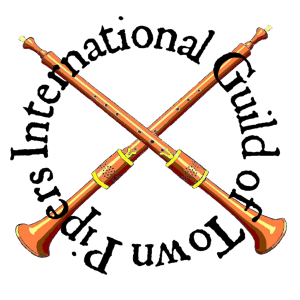York Waits
Also see:
York Sheriffs Riding
York – Skeldergate Waites
York Music by Dr. James Merryweather
The three silver livery collars are worn by the sword-bearer, mace-bearer, and staff-bearer. They were formerly worn by the city waits and were in regular use by 1565; in 1566 a fourth collar was made when the number of waits was increased. They were repaired and partially remade in 1585, and two of the existing collars may be of that date. By the early 16th century the waits also wore the city arms on their sleeves, as did other civic officers later.
From: ‘Seals, Insignia, Plate, and Officers’, A History of the County of York: the City of York (1961), pp. 544-546.
URL: http://www.british-history.ac.uk/report.aspx?compid=36394&strquery=waits Date accessed: 12 May 2011.
Once a year on the Feast of St. John the Evangelist a special and impressive Installation of the Grand Master took place. Following Divine Service, conducted in the church in Coney Street by the Grand Chaplain, election to the office was confirmed by the Master Masons in the Lodge meeting at their usual Inn. From here,around midday, a procession of the Lodge members in full regalia was formed undertheir banner and, led by the Town Waites, they marched to either the Hall of the Merchant Adventurers in Piccadilly or of the Merchant Taylors in Aldwark. Here the full and formal Installation took place after which there was a proper banquet.
From: GRAND LODGE OF ALL ENGLAND AT YORK AND ITS PRACTICES, V.W. Bro. the Revd. Neville Barker Cryer, P.G.C.
Letter from Sir William Robinson, York, to his son Metcalfe at Tom’s Coffee House, Covent Garden, London Date 4 Jun 1716
Gout has made him lame, but hopes to be out and about for the thanksgiving celebrations [on the suppression of the Jacobite rebellion]: ‘our town designs to be very loyall, having orderd 40 pounds out of the public stock to be laid out in wine and bisket, in order to intertain the clergy and gentlemen at the Common Hall, from whence we are to proceed to the Minster in our formalitys, with drums, trumpets and the waits’; the celebrations on 28-29 May
West Yorkshire Archives
The Resurrection of John Bartendale 27th March 1634.John Bartendale was a piper who committed some felony (the records appear to incomplete as to the nature of his crime) and was sentenced to death at York Tyburn*. After his hanging, his body was cut down and buried near the gallows. Shortly afterwards, a member of the Vavasour family of Hazlewood** was riding past the grave when he fancied he saw the earth moving. Dismounting, he and his manservant uncovered the body within – which proved to be Bartendale, who somehow had survived his execution. The criminal was delivered back to the Castle and held until the next assizes. Brought in front of a judge, his deliverance was taken as a portent and he was given a full and free pardon. After his brush with death, he is said to have led a wholesome life and when asked about the experience, described how “flashes of fire” darted into his eyes before he fell unconscious. |
||
LatinIbi Tibicen apprehensus, |
Google TranslateThe player was arrested, |
Another VersionHere a piper apprehended, |
Notes:*York Tyburn was situated to the south of the city on ground is now incorporated into York racecourse. **Hazlewood: See www.hazlewood-castle.co.uk for its current existence and Wikipedia for its history. |
||
| 1679 Nathan Harrison (“musition, wait”) was admitted a freeman of York, gratis. From: Notes and Queries (1905), W.C.B. quoting from York Corporation. |
York 1713According to Cowgill and Holman, “Music in the British Provinces 1690-1914”, Ashgate, 2007, York Waits played in the minster in a service of celebration for the Peace of Utrecht in 1713, their last performance in the minster (at least until their 1970s revival). |
YORK
“Yorkshire Folklore Journal, vol. 1”, J. Horsfall Turner, 1890
From Alan Radford, 4th February 2020.
“On the lst December, 1571, it was ordered and agreed that the common waits of the city of York, for divers good cause s and considerations, shall from hence forth use and keep their morning watch with their instruments accustomed, every day in the week except only Sundays, and in the time of Christmas only, any custom or usage heretofore had and used amongst them, or others before them to the contrary, notwithstanding. But on the 2nd of February, 1770, another order was made, which is read to them on‘ their several appoint ments, as follows You shall be obedient to the Lord Mayor, or his Deputy for the time being, and shall attend and play upon such musical instruments as you are best masters of, in all service of the Corporation when required bv himor his Deputy. You shall attend the Sheriffs of this city in their public cavalcade to read the proclamation on or about Martinmas, as also each Sheriff, on the day he makes an entertainment for the Lord Mayor and Aldermen, for which service you shall receive from each Sheriff one guinea, but if the Sheriffs, or either of them, require your further attendance for the entertainment of their friends after the aforesaid days , then you shall be paid as such service may deserve. You Shall call the city from the Monday after Martinmas to the end of February, that is every Monday, Wednesday, and Friday in the morning, (Fast days and Christmas week excepted.”
O. HANLEY.
Number of Waits employed by York
Payment records for the York Waits and their equipment
Payment records for York Waits’ Livery
